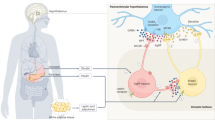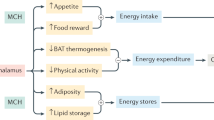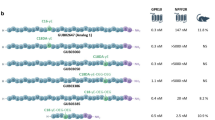Abstract
OBJECTIVE:
Current anti-obesity monotherapies have proven only marginally effective and are often accompanied by adverse side effects. The cannabinoid 1 (CB1) receptor antagonist rimonabant, while effective at producing weight loss, has been discontinued from clinical use owing to increased incidence of depression. This study investigates the interaction between the cannabinoid and melanin-concentrating hormone (MCH) systems in food intake, body weight control, and mood.
DESIGN:
Lean male C57BL/6 mice were injected i.p. with rimonabant (0.0, 0.03, 0.3 and 3.0 mg kg−1) or the MCH1-R antagonist SNAP-94847 (0.0, 1.0, 5.0 and 10.0 mg kg−1) to establish dose response parameters for each drug. Diet-induced obese (DIO) mice were given either vehicle, sub-threshold dose of rimonabant and SNAP-94847 alone or in combination. Impact on behavioral outcomes, food intake, body weight, plasma metabolites and expression of key metabolic proteins in the brown adipose tissue (BAT) and white adipose tissue (WAT) were measured.
RESULTS:
The high doses of rimonabant and SNAP-94847 produced a reduction in food intake after 2 and 24 h. Combining sub-threshold doses of rimonabant and SNAP-94847 produced a significantly greater loss of body weight in DIO mice compared with vehicle and monotherapies. In addition, combining sub effective doses of these drugs led to a shift in markers of thermogenesis in BAT and lipid metabolism in WAT consistent with increased energy expenditure and lipolysis. Furthermore, co-administration of rimonabant and SNAP-94847 produced a transient reduction in food intake, and significantly reduced fat mass and adipocyte size. Importantly, SNAP-94847 significantly attenuated the ability of rimonabant to reduced immobility time in the forced swim test.
CONCLUSION:
These results provide proof of principle that combination of rimonabant and a MCH1 receptor antagonist is highly effective in reducing body weight below that achieved by rimonabant and SNAP-94847 monotherapies. In addition, the combination therapy normalizes the rimonabant-induced behavioral changes seen in the forced swim test.
This is a preview of subscription content, access via your institution
Access options
Subscribe to this journal
Receive 12 print issues and online access
$259.00 per year
only $21.58 per issue
Buy this article
- Purchase on Springer Link
- Instant access to full article PDF
Prices may be subject to local taxes which are calculated during checkout






Similar content being viewed by others
References
Cooke D, Bloom S . The obesity pipeline: current strategies in the development of anti-obesity drugs. Nat Rev Drug Discov 2006; 5: 919–931.
Rinaldi-Carmona M, Barth F, Héaulme M, Shire D, Calandra B, Congy C et al. SR141716A, a potent and selective antagonist of the brain cannabinoid receptor. FEBS Lett 1994; 350: 240–244.
Calle EE, Rodriguez C, Walker-Thurmond K, Thun MJ . Overweight, obesity, and mortality from cancer in a prospectively studied cohort of U.S. adults. N Engl J Med 2003; 348: 1625–1638.
Despres JP, Golay A, Sjostrom L . Effects of rimonabant on metabolic risk factors in overweight patients with dyslipidemia. N Engl J Med 2005; 353: 2121–2134.
Di Marzo V, Goparaju SK, Wang L, Liu J, Batkal S, Jaral Z et al. Leptin-regulated endocannabinoids are involved in maintaining food intake. Nature 2001; 410: 822–825.
Hubert HB, Feinleib M, McNamara PM, Castelli WP . Obesity as an independent risk factor for cardiovascular disease: A 26-year follow-up of participants in the Framingham Heart Study. Circulation 1983; 67: 968–977.
Borowsky B, Durkin MM, Ogozalek K, Marzabadi MR, DeLeon J, Lagu B et al. Antidepressant, anxiolytic and anorectic effects of a melanin-concentrating hormone-1 receptor antagonist. Nat Med 2002; 8: 825–830.
Verty ANA, Allen AM, Oldfield BJ . The Endogenous Actions of Hypothalamic Peptides on Brown Adipose Tissue Thermogenesis in the Rat. Endocrinology 2010; 151: 4236–4246.
Shimada M, Tritos NA, Lowell BB, Flier JS, Maratos-Flier E . Mice lacking melanin-concentrating hormone are hypophagic and lean. Nature 1998; 396: 670–674.
Georgescu D, Sears RM, Hommel JD, Barrot M, Bolaños CA, Marsh DJ et al. The hypothalamic neuropeptide melanin-concentrating hormone acts in the nucleus accumbens to modulate feeding behavior and forced-swim performance. J Neurosci 2005; 25: 2933–2940.
Cota D, Marsicano G, Tschop M, Grubler Y, Flachskamm C, Schubert M et al. The endogenous cannabinoid system affects energy balance via central orexigenic drive and peripheral lipogenesis. J Clin Invest 2003; 112: 423–431.
Huang H, Acuna-Goycolea C, Li Y, Cheng HM, Obrietan K, van den Pol AN . Cannabinoids excite hypothalamic melanin-concentrating hormone but inhibit hypocretin/orexin neurons: implications for cannabinoid actions on food intake and cognitive arousal. J Neurosci 2007; 27: 4870–4871.
Verty ANA, Boon WM, Mallet PE, McGregor IS, Oldfield BJ . Involvement of hypothalamic peptides in the anorectic action of the CB receptor antagonist rimonabant (SR 141716). Eur J Neurosci 2009; 29: 2207–2216.
Verty ANA, Allen AM, Oldfield BJ . The effects of rimonabant on brown adipose tissue in rat: implications for energy expenditure. Obesity 2009; 17: 254–261.
Stefanidis A, Verty ANA, Allen AM, Owens NC, Cowley MA, Oldfield BJ . The role of thermogenesis in antipsychotic drug-induced weight gain. Obesity 2009; 17: 16–24.
Verty ANA, McFarlane JR, McGregor IS, Mallet PE . Evidence for an interaction between CB1 cannabinoid and melanocortin MCR-4 receptors in regulating food intake. Endocrinology 2004; 145: 3224–3231.
Verty ANA, McGregor IS, Mallet PE . Consumption of high carbohydrate, high fat, and normal chow is equally suppressed by a cannabinoid receptor antagonist in non-deprived rats. Neurosci Lett 2004; 354: 217–220.
Verty ANA, McGregor IS, Mallet PE . Evidence for an interaction between CB1 cannabinoid and oxytocin receptors in food and water intake. Neuropharmacology 2004; 47: 593–603.
Verty ANA, Singh ME, McGregor IS, Mallet PE . The cannabinoid receptor antagonist SR 141716 attenuates overfeeding induced by systemic or intracranial morphine. Psychopharmacology 2003; 168: 314–323.
Bermudez-Silva FJ, Viveros MP, McPartland JM, Rodriguez de Fonseca F . The endocannabinoid system, eating behavior and energy homeostasis: the end or a new beginning? Pharmacol Biochem Behav 2010; 95: 375–382.
Pissios P . Animals models of MCH function and what they can tell us about its role in energy balance. Peptides 2009; 30: 2040–2044.
Cannon B, Nedergaard J . Brown adipose tissue: Function and physiological significance. Physiol Rev 2004; 84: 277–359.
Saely CH, Geiger K, Drexel H . Brown versus White Adipose Tissue: A Mini-Review. Gerontology 2012; 58: 15–23.
Quarta C, Bellocchio L, Mancini G, Mazza R, Cervino C, Braulke LJ et al. CB(1) signaling in forebrain and sympathetic neurons is a key determinant of endocannabinoid actions on energy balance. Cell Metab 2010; 11: 273–285.
Jo YH, Chen YJ, Chua SCJ, Talmage DA, Role LW . Integration of endocannabinoid and leptin signaling in an appetite-related neural circuit. Neuron 2005; 48: 1055–1066.
Lihn AS, Jessen N, Pedersen SB, Lund S, Richelsen B . AICAR stimulates adiponectin and inhibits cytokines in adipose tissue. Biochem Biophys Res Commun 2004; 316: 853–858.
Perwitz N, Wenzel J, Wagner I, Büning J, Drenckhan M, Zarse K et al. Cannabinoid type 1 receptor blockade induces transdifferentiation towards a brown fat phenotype in white adipocytes. Diabetes Obes Metab 2010; 12: 158–166.
Thornton C, Sardini A, Carling D . Muscarinic receptor activation of AMP-activated protein kinase inhibits orexigenic neuropeptide mRNA expression. J Biol Chem 2008; 283: 17116–17122.
Kahn BB, Flier JS . Obesity and insulin resistance. J Clin Invest 2000; 106: 473–481.
Kim JY, Nolte LA, Hansen PA, Han DH, Ferguson K, Thompson PA et al. High-fat diet-induced muscle insulin resistance: relationship to visceral fat mass. Am J Physiol Regul Integr Comp Physiol 2000; 279: R2057–R2065.
Sindelka G, Skrha J, Prázn M, Haas T . Association of obesity, diabetes, serum lipids and blood pressure regulates insulin action. Physiol Res 2002; 51: 85–91.
Heiling VJ, Miles JM, Jensen MD . How valid are isotopic measurements of fatty acid oxidation? Am J Physiol Regul Integr Comp Physiol 1991; 261: E572–E577.
Jensen MD . Diet effects on fatty acid metabolism in lean and obese humans. Am J Clin Nutr 1998; 67 (3 Suppl): 531S–534S.
Marchesini G, Moscatiello S, Di Domizio S, Forlani G . Obesity-associated liver disease. J Clin Endocrinol Metab 2008; 93 (11 Suppl 1): S74–S80.
Johansson K, Neovius K, DeSantis SM, Rössner S, Neovius M . Discontinuation due to adverse events in randomized trials of orlistat, sibutramine and rimonabant: A meta-analysis. Obes Rev 2009; 10: 564–575.
André A, Gonthier MP . The endocannabinoid system: Its roles in energy balance and potential as a target for obesity treatment. Int J Biochem Cell Biol 2010; 42: 1788–1801.
Herkenham M, Lynn AB, Little MD, Johnson MR, Melvin LS, de Costa BR et al. Cannabinoid receptor localization in brain. Proc Natl Acad Sci USA 1990; 87: 1932–1936.
Sears RM, Liu RJ, Narayanan NS, Sharf R, Yeckel MF, Laubach M et al. Regulation of nucleus accumbens activity by the hypothalamic neuropeptide melanin-concentrating hormone. J Neurosci 2010; 30: 8263–8273.
Kalueff AV, Wheaton M, Murphy DL . What's wrong with my mouse model? Advances and strategies in animal modeling of anxiety and depression. Behav Brain Res 2007; 179: 1–18.
Takahashi E, Katayama M, Niimi K, Itakura C . Additive subthreshold dose effects of cannabinoid CB(1) receptor antagonist and selective serotonin reuptake inhibitor in antidepressant behavioral tests. Eur J Pharmacol 2008; 589: 149–156.
Tzavara ET, Davis RJ, Perry KW, Li X, Salhoff C, Bymaster FP et al. The CB1 receptor antagonist SR141716A selectively increases monoaminergic neurotransmission in the medial prefrontal cortex: implications for therapeutic actions. Br J Pharmacol 2003; 138: 544–553.
Acknowledgements
This study was supported by a grant from the National Health and Medical Research Council to Prof Oldfield and Dr Verty (Grant Number: 3160479). ANAV is the recipient of the National Health and Medical Research Council (NHMRC) Peter Doherty Postdoctoral Research Fellowship.
Author information
Authors and Affiliations
Corresponding author
Ethics declarations
Competing interests
The authors declare no conflict of interest.
Rights and permissions
About this article
Cite this article
Verty, A., Lockie, S., Stefanidis, A. et al. Anti-obesity effects of the combined administration of CB1 receptor antagonist rimonabant and melanin-concentrating hormone antagonist SNAP-94847 in diet-induced obese mice. Int J Obes 37, 279–287 (2013). https://doi.org/10.1038/ijo.2012.35
Received:
Revised:
Accepted:
Published:
Issue Date:
DOI: https://doi.org/10.1038/ijo.2012.35
Keywords
This article is cited by
-
Multifaceted actions of melanin-concentrating hormone on mammalian energy homeostasis
Nature Reviews Endocrinology (2021)
-
Novel analgesic effects of melanin-concentrating hormone on persistent neuropathic and inflammatory pain in mice
Scientific Reports (2018)
-
Pro-inflammatory obesity in aged cannabinoid-2 receptor-deficient mice
International Journal of Obesity (2016)
-
New insights on the role of the endocannabinoid system in the regulation of energy balance
International Journal of Obesity (2016)



